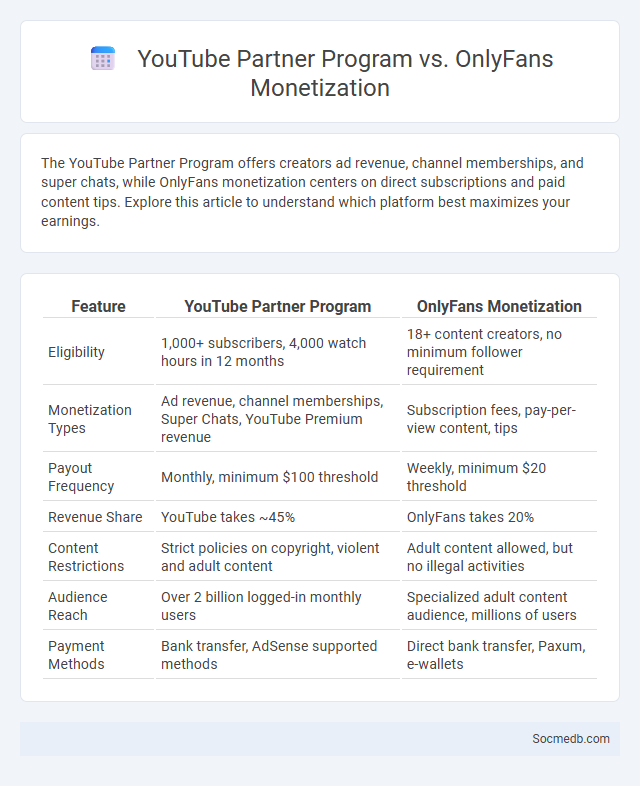
Photo illustration: YouTube Partner Program vs OnlyFans Monetization
The YouTube Partner Program offers creators ad revenue, channel memberships, and super chats, while OnlyFans monetization centers on direct subscriptions and paid content tips. Explore this article to understand which platform best maximizes your earnings.
Table of Comparison
| Feature | YouTube Partner Program | OnlyFans Monetization |
|---|---|---|
| Eligibility | 1,000+ subscribers, 4,000 watch hours in 12 months | 18+ content creators, no minimum follower requirement |
| Monetization Types | Ad revenue, channel memberships, Super Chats, YouTube Premium revenue | Subscription fees, pay-per-view content, tips |
| Payout Frequency | Monthly, minimum $100 threshold | Weekly, minimum $20 threshold |
| Revenue Share | YouTube takes ~45% | OnlyFans takes 20% |
| Content Restrictions | Strict policies on copyright, violent and adult content | Adult content allowed, but no illegal activities |
| Audience Reach | Over 2 billion logged-in monthly users | Specialized adult content audience, millions of users |
| Payment Methods | Bank transfer, AdSense supported methods | Direct bank transfer, Paxum, e-wallets |
Overview of YouTube Partner Program
The YouTube Partner Program (YPP) enables content creators to monetize their videos through ads, channel memberships, and merchandise shelf features. Eligibility requires at least 1,000 subscribers and 4,000 watch hours within the past 12 months, ensuring active engagement and content quality. By joining YPP, you gain access to advanced analytics and monetization tools that help maximize revenue and grow your channel's audience.
Key Features of OnlyFans Monetization
OnlyFans monetization offers creators multiple revenue streams such as subscription fees, pay-per-view content, and tips, enhancing your earning potential. Customizable subscription tiers allow you to target different audience segments effectively while exclusive content drives higher engagement and subscriber loyalty. Integrated analytics tools provide insights into subscriber behavior and revenue trends, optimizing your content strategy for maximum profitability.
Understanding Partner Programs Across Platforms
Partner programs on social media platforms like Facebook, Instagram, YouTube, and TikTok provide creators and brands with monetization opportunities through collaborations, sponsored content, and affiliate marketing. Each platform offers unique features such as Facebook's Brand Collabs Manager, YouTube's Partner Program with ad revenue sharing, and TikTok's Creator Fund that supports viral content creators financially. Understanding the specific requirements, payout structures, and audience targeting tools of these partner programs enhances success in optimizing reach and revenue generation.
Eligibility Requirements: YouTube vs. OnlyFans
YouTube requires users to be at least 13 years old, with monetization features available only to channels meeting 1,000 subscribers and 4,000 watch hours in the past 12 months. OnlyFans mandates users to be at least 18 years old, emphasizing explicit age verification to access subscription-based content. Both platforms enforce strict content guidelines, but YouTube focuses on broad advertiser-friendly standards, while OnlyFans allows adult content under regulated conditions.
Content and Audience Restrictions
Social media platforms enforce content restrictions to prohibit hate speech, misinformation, and explicit material, ensuring a safer environment for all users. Audience restrictions often include age gates and location-based limits, designed to comply with legal regulations and protect vulnerable groups. These policies impact content visibility and user engagement by tailoring access to appropriate demographics.
Revenue Streams Comparison
Social media platforms generate revenue primarily through advertising, subscriptions, and e-commerce integrations. Facebook's advertising income dominates with over $110 billion annually, while Twitter supplements ad revenue with subscription services like Twitter Blue. Instagram leverages influencer marketing and direct shopping features to diversify income, contrasting with LinkedIn's heavy reliance on premium subscriptions and recruitment advertising.
Payment Structure and Payout Frequency
Social media platforms typically implement diverse payment structures, including fixed rates, revenue sharing, and performance-based commissions, tailored to content creators and advertisers. Payout frequency varies widely, with common intervals ranging from weekly to monthly, ensuring timely compensation aligned with platform policies and creator agreements. Understanding these financial frameworks is crucial for influencers and marketers aiming to maximize earnings and cash flow efficiency.
Creator Support and Platform Policies
Social media platforms prioritize Creator Support by offering monetization options, content creation tools, and educational resources to help you grow your audience and earnings. Platform Policies are designed to maintain a safe and respectful environment, enforcing guidelines on content sharing, copyright, and community standards. Understanding these policies ensures your content remains compliant, maximizing your potential reach and engagement.
Brand Safety and Community Guidelines
Brand safety on social media ensures that advertisements and content are protected from appearing alongside harmful or inappropriate material, preserving brand reputation and consumer trust. Community guidelines establish clear rules for acceptable behavior and content, fostering a respectful, inclusive environment while minimizing misinformation and harmful interactions. Effective enforcement of these policies strengthens user engagement by promoting a secure and positive online experience.
Choosing the Right Platform for Monetization
Choosing the right social media platform for monetization depends on understanding your target audience and the type of content you create. Platforms like YouTube and Instagram offer strong monetization tools such as ad revenue, sponsored posts, and affiliate marketing suited for influencers and video creators. To maximize your earnings, focus on the platform where your audience is most active and where your content style aligns with the platform's dominant format.
 socmedb.com
socmedb.com